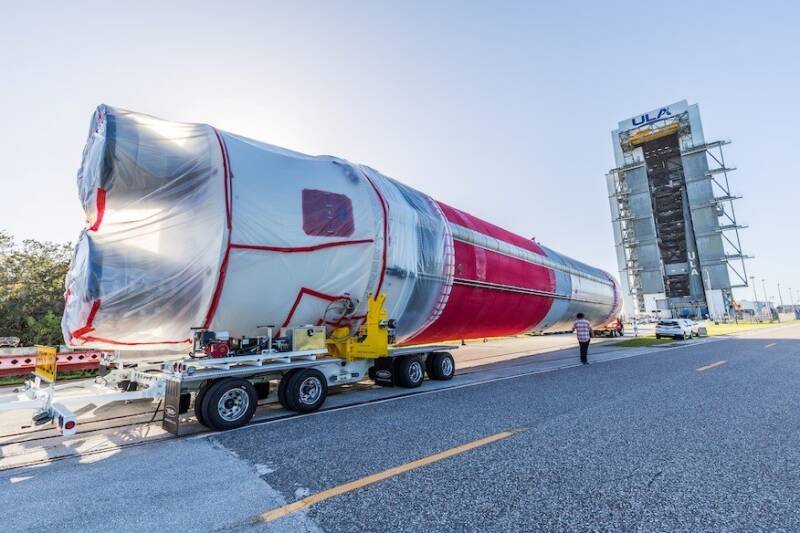Just over a week after its latest Atlas V launch, United Launch Alliance (ULA) rolled its next Vulcan rocket to the Vertical Integration Facility at Cape Canaveral Space Force Station on Wednesday morning, marking the start of preparations for the third Vulcan launch since the rocket's debut. This booster is the first to fly since Vulcan achieved full certification to carry national security payloads, a key milestone for ULA’s launch cadence and mission portfolio.

United Launch Alliance (ULA) preparing to liftits Vulcan first stage booster into the Vertical Integration Facility-G (VIF-G) adjacent to Space Launch Complex-41 at Cape Canaveral Space Force Station, Florida. Credit: United Launch Alliance
The stacking operation, known within ULA as “Launch Vehicle on Stand” (LVOS), was announced by company President and CEO Tory Bruno on social media. It sets the stage for the USSF-106 mission, a long-delayed but critical flight carrying the U.S. Air Force’s Navigation Technology Satellite-3 (NTS-3) among other classified payloads.
This particular Vulcan booster has been to the launch pad once before. It was originally positioned for the USSF-106 launch campaign in late 2023. However, delays in the certification process, compounded by a burn-through issue on a Northrop Grumman-built GEM 63XL solid rocket motor during the rocket’s second certification flight in October, forced ULA to pause national security launch plans and investigate the anomaly. Though the rocket still completed its mission successfully, the incident prompted several months of technical analysis and hardware upgrades.
During the delay, ULA opted to prioritize Amazon’s Project Kuiper—its satellite internet constellation—allowing the commercial customer to proceed with its first deployment. According to ULA’s Vice President of Government and Commercial Programs, Gary Wentz, this decision helped maximize pad availability and clear critical work needed on the USSF-106 booster.
By March 2024, the U.S. Space Force's Assured Access to Space office granted full certification for Vulcan to fly under the National Security Space Launch (NSSL) program. With 25 missions already awarded under the NSSL Phase 2 contract and more added in Phase 3, the path was clear for ULA to resume its dual-track launch cadence with both Atlas and Vulcan rockets.
ULA has since launched two Atlas V rockets carrying Kuiper satellites in April and June. Bruno has stated the company aims to complete 11 to 13 launches this year, with about half flying on Vulcan.
The next two Vulcan missions—USSF-106 and USSF-87—are both classified under the NSSL program. While most payload details remain confidential, the U.S. Air Force has confirmed that USSF-106 will carry the NTS-3 satellite, developed by L3Harris Technologies in partnership with the Air Force Research Laboratory (AFRL).
NTS-3 is a next-generation positioning, navigation, and timing (PNT) satellite built on Northrop Grumman’s ESPAStar bus. It will conduct over 100 experiments in near-geosynchronous orbit to test technologies aimed at countering electronic warfare threats such as GPS jamming and spoofing. Key features include multiple atomic clocks and Chimera, a robust authentication protocol to enhance navigation security for civilian users.
“This Vanguard not only aims to support GPS users through vital development of new technologies and techniques, but also to show how an agile and responsive U.S. satellite navigation architecture is paramount to defeating the most challenging threats to warfighter success,” said NTS-3 program manager Arlen Biersgreen.
Following the USSF-106 mission, ULA will launch the USSF-87 mission, which will carry a pair of Geosynchronous Space Situational Awareness Program (GSSAP) satellites, designed to enhance monitoring and tracking of objects in geostationary orbit.
After these NSSL missions, ULA plans to resume Kuiper deployments aboard Vulcan, alternating with Atlas launches throughout the remainder of 2025.


Add comment
Comments